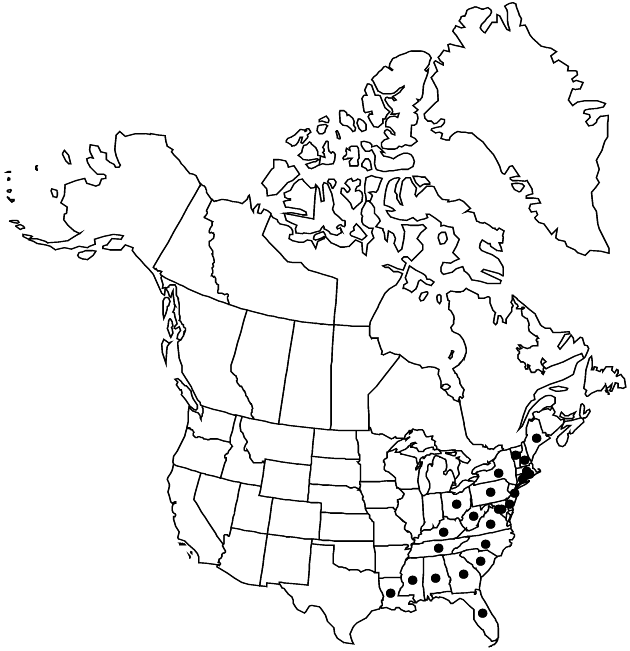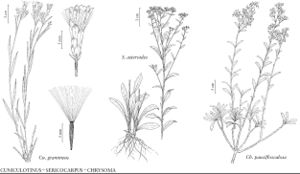Difference between revisions of "Sericocarpus asteroides"
Gen. Sp. Aster., 150. 1832.
FNA>Volume Importer |
imported>Volume Importer |
||
| (6 intermediate revisions by 2 users not shown) | |||
| Line 8: | Line 8: | ||
}} | }} | ||
|common_names=Toothed white-topped aster | |common_names=Toothed white-topped aster | ||
| − | |basionyms={{Treatment/ID/ | + | |special_status={{Treatment/ID/Special_status |
| + | |code=F | ||
| + | |label=Illustrated | ||
| + | }}{{Treatment/ID/Special_status | ||
| + | |code=E | ||
| + | |label=Endemic | ||
| + | }} | ||
| + | |basionyms={{Treatment/ID/Basionym | ||
|name=Conyza asteroides | |name=Conyza asteroides | ||
|authority=Linnaeus | |authority=Linnaeus | ||
| + | |rank=species | ||
| + | |publication_title=Sp. Pl. | ||
| + | |publication_place=2: 861. 1753 | ||
}} | }} | ||
|synonyms={{Treatment/ID/Synonym | |synonyms={{Treatment/ID/Synonym | ||
|name=Aster asteroides | |name=Aster asteroides | ||
|authority=(Linnaeus) MacMillan | |authority=(Linnaeus) MacMillan | ||
| − | }}{{Treatment/ID/Synonym | + | |rank=species |
| + | }} {{Treatment/ID/Synonym | ||
|name=Aster paternus | |name=Aster paternus | ||
|authority=Cronquist | |authority=Cronquist | ||
| + | |rank=species | ||
}} | }} | ||
|hierarchy=Asteraceae;Asteraceae tribe Astereae;Sericocarpus;Sericocarpus asteroides | |hierarchy=Asteraceae;Asteraceae tribe Astereae;Sericocarpus;Sericocarpus asteroides | ||
| Line 33: | Line 45: | ||
|elevation=0–1600 m | |elevation=0–1600 m | ||
|distribution=Ala.;Conn.;Del.;D.C.;Fla.;Ga.;Ky.;La.;Maine;Md.;Mass.;Miss.;N.H.;N.J.;N.Y.;N.C.;Ohio;Pa.;R.I.;S.C.;Tenn.;Vt.;Va.;W.Va. | |distribution=Ala.;Conn.;Del.;D.C.;Fla.;Ga.;Ky.;La.;Maine;Md.;Mass.;Miss.;N.H.;N.J.;N.Y.;N.C.;Ohio;Pa.;R.I.;S.C.;Tenn.;Vt.;Va.;W.Va. | ||
| − | |discussion=<p>Collections of Sericocarpus asteroides purportedly from Indiana and Wisconsin are of questionable provenance or chance introductions.</p> | + | |discussion=<p>Collections of <i>Sericocarpus asteroides</i> purportedly from Indiana and Wisconsin are of questionable provenance or chance introductions.</p> |
|tables= | |tables= | ||
|references= | |references= | ||
| Line 42: | Line 54: | ||
-->{{#Taxon: | -->{{#Taxon: | ||
name=Sericocarpus asteroides | name=Sericocarpus asteroides | ||
| − | |||
|authority=(Linnaeus) Britton | |authority=(Linnaeus) Britton | ||
|rank=species | |rank=species | ||
| Line 56: | Line 67: | ||
|publication title=Gen. Sp. Aster., | |publication title=Gen. Sp. Aster., | ||
|publication year=1832 | |publication year=1832 | ||
| − | |special status= | + | |special status=Illustrated;Endemic |
| − | |source xml=https:// | + | |source xml=https://bitbucket.org/aafc-mbb/fna-data-curation/src/2e0870ddd59836b60bcf96646a41e87ea5a5943a/coarse_grained_fna_xml/V19-20-21/V20_200.xml |
|tribe=Asteraceae tribe Astereae | |tribe=Asteraceae tribe Astereae | ||
|genus=Sericocarpus | |genus=Sericocarpus | ||
Latest revision as of 20:01, 5 November 2020
Plants 14–65 cm. Stems erect, puberulent. Leaves: basal persistent at flowering, winged-petiolate, blades oblanceolate to obovate or spatulate, 20–150 mm, serrate near apices, puberulent; cauline sessile, blades narrowly to broadly ovate, 10–110 × 4–30 mm, bases cuneate, margins serrate, distal becoming entire, apices acuminate to acute, faces puberulent. Heads 2–5 per branch, in corymbiform arrays. Involucres 4–7 mm at flowering. Peduncle bracts absent. Phyllaries in 3–4 series, outer 2–4 mm, mid 3–5 mm, glabrate. Ray florets 3–7; corolla tubes 2–4 mm, laminae 2–6 mm. Disc florets 9–20; corolla tubes 3–4 mm, lobes 0.6–2 mm. Ovaries fusiform-obconic, 0.8–2 mm, densely strigose; pappi: inner series 4–5 mm. 2n = 18.
Phenology: Flowering mid summer–early fall.
Habitat: Dry sandy, clay, and shaley open soils in fields and open mixed and pine woods, road margins, eastern deciduous forest
Elevation: 0–1600 m
Distribution

Ala., Conn., Del., D.C., Fla., Ga., Ky., La., Maine, Md., Mass., Miss., N.H., N.J., N.Y., N.C., Ohio, Pa., R.I., S.C., Tenn., Vt., Va., W.Va.
Discussion
Collections of Sericocarpus asteroides purportedly from Indiana and Wisconsin are of questionable provenance or chance introductions.
Selected References
None.
